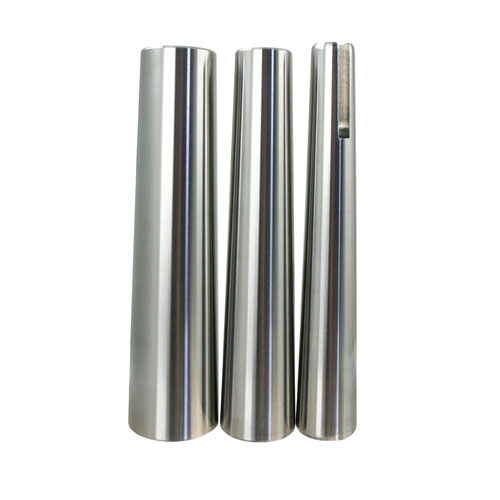Taking dents out of a saxophone body with a traditional dent ball on a rod can be difficult because the rod has a lot of flex, especially when working on larger saxophones with a long rod. The dent ball only contacts the body in a single spot, which makes accuracy tricky and can leave big signs of dent work having been done. Dent balls are even harder to use when the saxophone is severely damaged from a fall and the body is creased because you must balance a crease on the surface of the ball.
We created our Saxophone Body Mandrels to effectively remove damage from many different tapers, makes, and models of saxophones. A traditional mandrel is a single piece, which is what factories use to form the body of the instrument. When doing dent work and body work, you really don’t need a mandrel that goes the entire length of the body. We make our body mandrels in shorter sections so that you can select the right size and taper for the specific part of the body you are working on. The mandrel sections are staggered with an inch of overlap on the end of each piece so that there is a solid working surface of every diameter without the risk of the correct diameter being where the two pieces connect.
The sets also work together for alto, tenor, and the majority of a baritone body by threading on the next largest size, so there is no need to have multiple full size mandrels for different makes, models, and sizes of saxophones.
A mandrel has a lot of advantages over a dent ball for doing dent work. When combined with a burnisher or roller, you are working against a much more stable platform so there’s no need to worry about flex and bouncing. You are also able to select the correct taper and diameter regardless of where in the body the dent occurs so it substantially reduces the possibility of going too far when removing dents.
The mandrel also works great for straightening a serious bend or crease. By pushing the mandrel through, you can use the edge of the mandrel to push past the crease or bend, quickly making the body much closer to its intended shape. The mandrels are also great for mechanically raising low spots or pushed down tone holes, which is especially helpful for instruments with rolled tone holes.
Another issue with traditional mandrels that we solved when making our mandrels is how delicate the threads are. The threads are most delicate right where they come out of the rod. Our mandrels make use of recessed threads that are protected from wear and damage. The threads are hardened and make use of permanent Loctite so they can be securely tightened.
There is a cutaway slot for octave vents on two of the mandrel pieces, which should always be oriented to the bottom so that the useable working surface is face up.
These mandrels are lifetime tools made from stainless steel in-house in Wilmington, NC so they won’t rust and don’t require upkeep like many steel mandrels which suffer from rust and corrosion, creating an imperfect work surface. Like the majority of the tools we make in-house, the mandrels are the result of years of research, creative problem solving, testing, and actual shop use and we love them! How about you? Happy Repairing!




